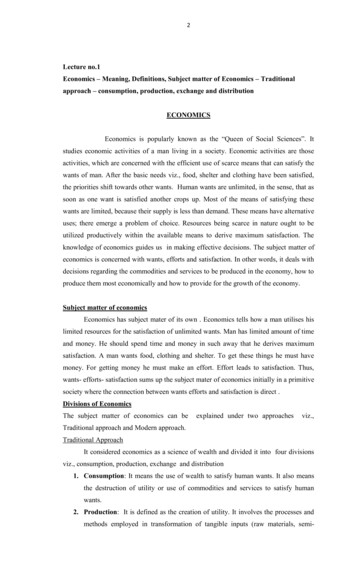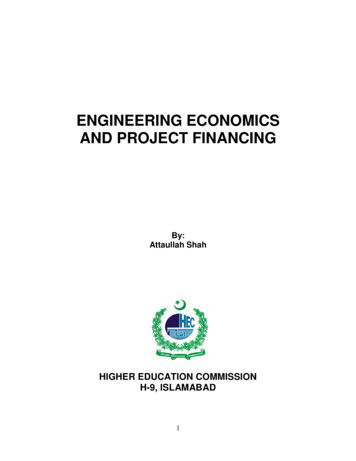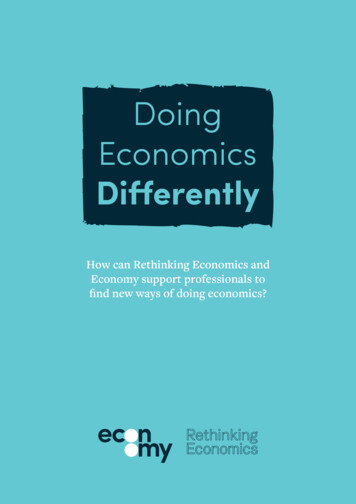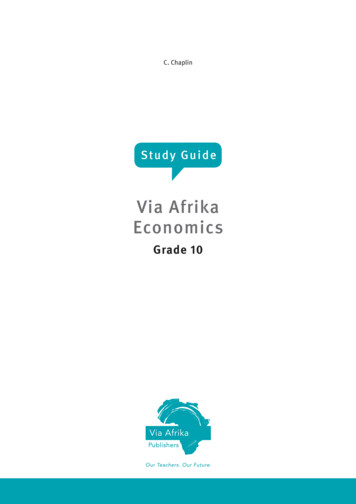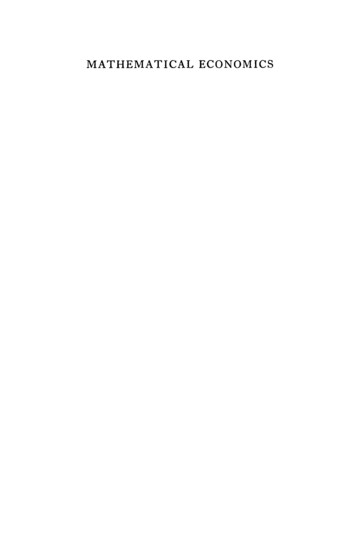
Transcription
Economics of Strategy, 7th EditionBy: David Besanko, David Dranove, Mark Shanley, and Scott SchaeferNotes By: Anton ZitzHigh Level Summary1. This text evaluates strategy through the foundation of several key economic principles to makesense of Company’s decisions and actions and argues mastering these principles is a key tounderstanding and assessing strategy.2. The key economic principles discussed in depth included economies of scale and scope,transaction-cost economics (for vertical integration decision), entry, and commitment and agencyissues.3. To successfully formulate and implement strategy you must consider classes of issues such as firmboundaries (both horizontal and vertical), market and competitive analysis, positioning anddynamics. and internal organization of the firm.Summation of Key Themes and TakeawaysCosts are an important focus area in business analysis to learn about its unit economics, competitiveadvantage, and strategic decision making.1. Fixed and variable costs differ in that variable costs increase as output increases but fixed costs donot. Analyzing fixed and variable costs are hard for several reasons: some costs have both fixedand variable components; some costs are semi-fixed in that they are fixed within a certain intervalbut variable between intervals; some costs may be fixed and not sensitive to output, but are basedon other decisions management makes; and in the short-term most costs are fixed but in the longterm most costs are variable as firms can adjust operations.2. Average costs are total costs divided by output and can rise, stay flat, or fall with respect to outputand may give you some insight into possible scale economies. Marginal costs represent theincremental cost of selling one more unit of output. When making decisions, it is important forCompanies to differentiate between the two. To realize lower average costs, a firm must havethroughput whether its increasing output or its user base to realize scale economies.3. Sunk costs are costs that cannot be avoided no matter what decision is made. Avoidable costs arejust the opposite. When making a decision, a manager should ignore sunk costs and only focus onavoidable costs but many don’t. Whether or not a cost is sunk depends on the decision being madeand the options at hand. Sunk costs and fixed costs are not necessarily the same. Sunk costs arevaluable to study as they can affect many strategic decisions such as pricing, rivalry among firms,entry and exit, market structure, scale, and new technology.4. Economic costs need to be considered when making decisions not only accounting costs. Economiccosts usually involve assessing what the opportunity cost is of deploying something to its next bestuse.Demand can be influenced by prices, substitutes, complements, incomes, tastes, quality, andadvertising and demand sensitivity to price is measured by elasticity.Economies of scale and scope are important concepts to understand that determine horizontalboundaries of the firm and are related to business strategy.1. Economies of scale and scope result in costs savings either through increased output (scale) orthrough increasing the variety of goods and services sold (scope); the source of scale and scope
economies are indivisible fixed costs that cannot be scaled down. Special sources of economies ofscale and scope include density, purchasing, advertising, research and development, and cubesquare rule.2. Production processes that are capital intensive are much more likely to display economies of scaleand scope than processes that are material and/or labor intensive.3. Firms looking to drive a single activity are focused on economies of scale whereas a firm focusedon driving a set of related activities are focused on driving economies of scope.The learning curve represents reductions in costs and improved pricing from accumulatingexperience over time.Vertical boundaries involve the make-or-buy decision for the firm: what activities should the firmbuy from the market and what activities should it perform itself? Keep in mind there are a range ofalternatives here and this decision is not actually binary.1. At the highest level, the make-or-buy decision is a tradeoff between costs savings of performingthe activity internally balanced by increasing internal agency costs versus the transaction costs ofengaging with the market and concerns about information and being held up by a trading partner.2. This decision is resolved considering information, coordination and holdup problems: if theseproblems do not exist, a firm can use the market. If they do exist, can they be mitigated or eliminatedusing contracts (which favors the market) or governance (which favors making).3. The firm exists in the first place because of transaction costs: the time and expense of negotiating,writing, and enforcing contracts and the costs that come from a company exploiting a contract.Market structure can range from perfectly competitive markets to monopolistically competitive tooligopoly and monopoly and is measured by the number and distribution of firms. The structure ofthe market dictates strategy and how firms do (or do not) interact with one another. Prices andmargins are usually higher in concentrated industries.1. For a firm to compete with one another, it must mean the strategic choices of one firm affect anotherand this can occur directly or indirectly.2. Products and services can be vertically differentiated (just better) or horizontally differentiatedwhich not only affects competition but where a firm is choosing to position itself.Think of market entry as an investment in which the entrant must sink some capital that may not berecovered in hopes of a long-term positive NPV opportunity. Barriers to entry are the sum of sunkcosts and expectations about post-entry competition. Barriers to entry can be structural such ashaving lower cost or superior access to an asset or they or can be strategic from actions a firm takessuch as aggressive pricing or strategic bundling.1. Barriers to entry usually result from some form of asymmetry: sunk costs the incumbent hasincurred that the entrant must now bear.2. Sunk costs can arise from entry and create economies of scale but they don’t have to.Commitments are important strategic actions a firm can take to elicit a response form thecompetition and establish a reputation. When making commitments, flexibility can be an importantfactor and is often expressed by delaying important decisions and taking advantage of real options.
A market structure can only be partially explained by the relationship between market size andminimum efficient scale. John Sutton theorizes sunk costs and scale economies are important, butconsumers tend to gravitate towards brands and brand building activities require significant sunkcosts explaining why consumer markets result in a handful of large brands and many smaller nicheplayers. Sutton also points out these sunk cost investments are not determined by some productiontechnology, but by management decisions making them “endogenous sunk costs”. Two categories ofthese endogenous sunk costs include advertising and research and development.Michael Porter’s Five Forces is an industry analysis that looks at economic profitability for theaverage firm a strong force implies eroded economics profits. The Five Forces are: entry, substitutesand complements, buyer power, supplier power, and internal rivalry which is driven by the fourother forces. Strategically, a Company should not take a strong force head-on, but rather positionitself where the force is the weakest or try to insulate itself from a force. A good complement to theFive Forces framework is looking at a firm’s “Value-Net” for an ecosystem-based business.A firms’ economic profitability comes from a combination of its market economics (determined byFive Forces) and its relative cost and benefit position. To understand Value Creation (ConsumerSurplus Producer Surplus), you need analyze the drivers of benefits and costs. For the benefit, youneed to determine what drives the benefit and how does it fill needs better than substitutes. For thecost, you need to determine what costs are sensitive to scale or learning economies. A firm can createvalue by performing activities differently or by performing them better by leveraging its resourcesand capabilities. A firm’s strategic position is chosen and represents the “how” and “where” of valuecreation. The how is will the firm create value via cost leadership, benefit leadership, or both? Thewhere is will the firm seek to create value with a broad coverage strategy or a narrow coveragestrategy? A broad coverage strategy involves offering a wide array of products to a wide array ofcustomers and is predicated on achieving economies of scope. A narrow coverage strategy focuses oncreating value by selling a narrow range of products to a narrow range of customers and can makesense if the customer is overserved or if the firm is pursuing scale or learning economies in a marketniche. A firm is more likely in control of its positioning than it is of its market economics.Most products rely on two benefit strategies: vertical differentiation which is when a product isunambiguously better than another leaving price aside and horizontal differentiation which is whena product is tailored to a customer’s idiosyncratic tastes or needs. The internet has lowered searchcosts for search, experience, and credence goods with some interesting effects: it has likely raised theprice elasticity of demand in many industries but the internet has also made strategies aroundhorizontal differentiation more possible through ad targeting and data accumulated on customers.Google and Facebook do not even sell products but rather the attention of their audiences toadvertisers who end up ceding some of their profits to these companies. As data gets more detailedand ad targeting gets better, these advantages will only increase without a direct relationship withthe consumer.Sustaining competitive advantage depends on an advantage that is not well understood or difficult toimitate. The key to maintaining profitability relies in having a defensible business and one that detersentry. This can be done by possessing resources and capabilities that allow you to competeasymmetrically against others or the business has barriers from isolating mechanisms: economic
forces that prevent an advantage from being copied or neutralized. Adaptability of a company is animportant trait to sustaining long-term advantage.1. Isolating mechanisms can be grouped into impediments to imitation such as patents, access, scaleand early mover advantages such as learning economies, reputation, switching costs, and networkeffects.2. For a technology to be disruptive, it really needs to change value creation (“B-C”) in a way theincumbent cannot respond to the entrant.Performance based incentives can solve hidden information problems in principal-agentrelationships within organizations but they have limits.Organizational structure is an important consideration in driving strategy and can often reveal notonly why a firm is successful but why it may be failing especially if the strategic environment changesaround them. Stated simply: structure should follow strategy. Four typical organizational structuresinclude the U-form structure, M-form structure, Matrix structure and the Network structure. TheU-form looks to drive economies of scale by dividing the organization by functions such asproduction, marketing, and distribution. The M-form is a divisional structure that usually developsfrom a U-form with the business unit making operational decisions and corporate focused onstrategic decisions and capital allocation. The Matrix form will organize along multiple dimensionsdepending on economies of scale and scope. Finally, a Network structure may limit scope economiesbut is meant to be flexible and typically used by technology companies.1. Organizing dimensions of the firm driven by considerations about economies of scale, scope, andlearning balanced by transaction costs, agency costs, and a consideration of firm boundaries.Firms operate within both an internal context driven by power and culture. A culture can be an assetuntil it isn’t which usually occurs because of some exogenous industry change. Many firms operatein an external environment based on “industry logics”, a sort of culture for an industry but it isn’tclear if firm practices come from industry logics or firm practices drive industry logics.Key Takeaways By ChapterPreface1. This book argues there is a set of business principles that apply at all times to all sectors of theeconomy and sound management of these principles will lead to success and not some blindadherence to the “strategy du jour”.2. This book serves as an economic foundation for strategic analysis and the principles covered in thisbook related to strategy include economies of scale, transaction-cost economics, oligopolytheory, entry, commitment, incentives for innovation, and agency.Introduction1. Book’s Objective: is to study and analyze strategy from the perspective of economics.2. A key element of strategy is making decisions not only about what to do, but what not to do andhow you face those trade-offs will determine if you achieve success in the long-term.a. Insight: At its core, business is really about decision making.b. Connection: Michael Porter explains that facing trade-offs is a key linchpin of strategymaking it stronger and also alludes to the face part of strategy entails what an organizationwill not do.
3. Central Theme: you can learn a lot by studying the durable economic principles that appearin many strategic situations and this value shows up in how firms compete and organizethemselves and allows you to develop a more secure foundation for making good strategicdecisions.4. The need to study principles is important because it is difficult to take one firm’s experience andanalogize it to what makes all firms successful that often appear in books such as Good to Greatfor example.a. Connection: The Halo Effect by Phil Rosenzwieg is a book that actually emphasizes thedangers of this sort of thinking.5. What we are really seeking to understand is what works in advance, and not what works in hindsightand a good strategy textbook can provide general principles that underlie strategic decisions butsuccess depends on matching principles and conditions.6. Although there can be some element of “luck” in strategy is usually about using the right strategiesto exploit the right profit opportunities at the right time; attached to this idea is that a firm needs tobe adaptable as nothing is static.7. To successfully formulate and implement strategy a firm must confront four classes of issues:a. Boundaries of the firm: What should the firm do, how large should it be, and whatbusinesses should it be in?i. These boundaries extend in three different directions: horizontal, vertical, andcorporate.1. Horizontal: how much of the product market should the firm serve? Be amass market provider or serve some niche?2. Vertical: what activities should the firm preform itself and what should itpurchase?3. Corporate: what is the set of distinct businesses the firm should competein?b. Market and competitive analysis: What is the nature of the markets in which a firmcompetes and the nature of the competitive interactions of firms in those markets?c. Positioning and dynamics: How should the firm position itself to compete, what should bethe basis of its competitive advantage, and how should it adjust over time?i. Positioning is how you compete at a point in time (i.e. low cost or differentiated)ii. Dynamics is how firm accumulates resources and capabilities and how it reacts.d. Internal Organization: how should the firm organize its structure and systems internally?Economics Primer: Basic Principles1. A firm has control over internal functions such as finance, marketing, and production but has nodirect control over market share or profits; the market and economic relationships determine ifthe firm’s decisions translate into success.a. Connection: Michael Porter says the economic success of a business is determined by theunderlying economics of the industry and can be assessed using the “Five ForcesFramework” and at the Company level success will be determined by how the Companypositions itself relative to the “Five Forces”.2. Costsa. Fixed and variable costs are different in that variable costs increase as output increases andfixed costs do not.b. When analyzing fixed and variable costs you must keep three important points in mind:i. The dividing line between the two can be very fuzzy because 1) certain costs (i.e.maintenance, advertising, and promotion) may have fixed and variable
components and other costs are 2) semifixed which means they are fixed overcertain ranges of output and variable over other ranges of output; in other words itis fixed within certain internals but variable between intervals.1. Insight: A good example of semifixed costs is delivery costs of fillingtrucks can go down as a truck gets filled, but the incremental unit of outputcould result in a new truck.2. This is an obvious point, but keep in mind that if a firm increases itcapacity, its fixed costs will not remain fixed so this is always a movingtarget in a sense.ii. Even though a cost may be fixed (in that it is not sensitive to the level of output),it can still be affected by other decisions a firm makes.1. Examples could include hanging wire to connect utility customers that donot depend on the KW produced by the utility and advertising spend whichcan be discretionary but have a fixed element.iii. Whether costs are fixed or variable really depend on the time period that the givendecisions are contemplated with the implication that costs are a lot more “fixed”in the short-term than in the long-term as a firm can readjust its activities andphysical capital to align with a new business environment.1. There is always more flexibility in the “long-term” and this can make morecosts “variable” that appear “fixed”.2. The book provides an example of airline fare discounting and what costsare fixed and then can be changed as the time period extends (i.e. itsworkers have been hired, schedule set, and plane leased).c. Average costs and marginal costsi. Average costs (AC) vary with output and will usually rise (diseconomies of scale),fall (economies of scale), or remain constant (constant returns to scale) as outputgoes up.ii. Minimum efficient scale (MES): the smallest level of output at which scaleeconomies have been exhausted.1. Connection: Michael Porter contends that Company’s only have to be “bigenough” which means they rarely dominate and this “big enough” isusually around 10% of the market. The error here is to assume there is justone scale curve in the industry but that is often not the case. Mostindustries have multiple scale curves each based on serving differentneeds.iii. Marginal cost refers to the rate of change in total cost with respect to output andoften depends on the total volume of output.1. Businesses often treat average cost and marginal costs as if they aresame and they are not and this can distort decision making.iv. When AC decreasing as a function of output, marginal cost is less than averagecost and AC is at a minimum when MC AC.d. The importance of time period: long-run versus short-run costs functionsi. Significant Point: to realize lower average costs, the firm must not only builda larger plant but also achieve sufficient output so the large plant is indeed theoptimal one.
1. Insight: In the new economy, I interpret this as having the most users (orsubscribers) and having the cost advantage depends on that throughput butjust expressed on the demand side.ii. Sometimes it is assumed that scale economies inherent in a production processwere limited or non-existent, but the firm is merely not selling enough output tocapture them so the value of throughput is important.1. Firms cannot fully support economies of scale unless they havesufficient inputs for production and distribution to get their productsto market.2. Insight: Putting this on its head, users are needed to drive cost advantagesotherwise you are not getting throughput on your investments.e. Sunk costsi. Managers should only consider costs that the decision actually affects as somecosts will be incurred no matter what decision is made and cannot be avoided andthese are called sunk costs.1. The opposite is avoidable costs and can be avoided if certain choices aremade.ii. Sunk costs and decision making: a decision make should ignore sunk costs whenmaking a decision and consider only avoidable costs.iii. Factors to keep in mind while examining sunk costs:1. Whether a cost is sunk or not depends on the decision being made and theoptions at hand and can be dynamic. For example, the book explains thecost of the ink cartridges are sunk with regard to the current pricingdecision but were not sunk at the point during which they were consideringbuying them.2. Sunk costs and fixed costs are not the same and they can be confused. Forexample, you need a locomotive and a crew whether you haul 1 car or 25and represents a fixed cost. However, the locomotive cost is not sunk asyou can repurpose the locomotive to another railroad or another route.iv. Sunk costs important for analyzing strategy and particularly for:1. Rivalry among firms.2. Entry and exit decisions.3. New technology decisions.f. Economic versus Accounting Costsi. Business decision making should not only consider accounting costs but alsoeconomic costs which is captured in the concept of opportunity costs.1. The economic costs of deploying resources in a particular activity is thevalue of the next best foregone alternative use of those resources.a. The book provides an example of raw material selling at belowmarket value is that cost of goods sold wouldn’t be cost but ratherselling the materials at market reflects which reflects the foregoneopportunity.ii. Accounting statements are useful in many ways but the concept of opportunity costprovides best basis for good economic decisions when the firm must choose amongcompeting alternatives.iii. Specific examples:
1. If a business could be liquidated for 100 million and investors wouldexpect to earn an 8% return and the value of its assets decline by 1% peryear, the opportunity cost of not deploying funds in another investmentwould be 9 million.2. A business someone starts that generates 150,000 in profit but insteadcould have been employed at a salary of 200,000 a year.3. Demand and Revenuesa. Demand is affected by certain variables such as the price of the product, the prices ofrelated products (substitutes), incomes and tastes of consumers, product quality,advertising, and various other factors.b. The law of demand states that price and quantity demanded will have an inverserelationship.i. Exception: This law may not hold if high prices confer prestige, enhance a productsimage, or when consumers use price to infer quality.1. Connection: In Alchemy, Rory Sutherland explains you can use marketingto either justify a high price or detoxify a low price.c. Elasticity of demand measures how sensitive quantity demanded of a product is to a changein the product’s price (Can be mathematically expresses as inelastic demand 1 and elasticdemand is 1).i. Factors that would make demand for a product elastic include:1. Little opportunity for differentiation and the ease with which consumerscan compare price (i.e. airline fares).2. Expenditures on the product are a large % of a consumers’ budget so theyare incentivized to shop around (i.e. cars, appliances, etc.).3. The product is an input into a final good whose demand is very elastic (i.e.components for personal computers).ii. Factors that would make demand for a product inelastic include:1. Comparisons for substitute products are difficult because product iscomplex and / or the product has many performance dimensions.2. For one reason or another (i.e. tax deduction or insurance), the buyer onlypays a fraction of the full price.3. A buyer would incur significant switching costs by switching to asubstitute product (i.e. Office software).4. A product could be an input into something with switching costs (i.e. tonerto a copier).iii. Brand-level versus industry-level Elasticities1. Just because demand for product is inelastic doesn’t mean each seller ofproduct is facing inelastic demand.2. The answer depends on what a firm expects its rivals to do; if they matchdemand facing seller should be inelastic if not it could be elastic.d. Total and Marginal Revenue: although one would assume marginal revenue is alwayspositive, one must consider in selling incremental units not only the price on the next unitsold, but also the reduced revenue on all the previous units sold (economists call this therevenue destruction effect).i. This is because most firms face a downward sloping demand curve.4. The theory of price and output determination by a profit-maximizing firm:a. Pricing and output decisions are assumed to have a profit motive.
b.c.d.e.If MR MC, the firm can increase profit by selling more and lowering its price.If MR MC, the firm can increase profit by selling less and raising its priceIf MR MC, the firm cannot increase profits and must be at optimal levels.Substituting MR for price elasticity of demand can help guide pricing decisions:i. A firm should lower price when price elasticity of demand exceeds the reciprocalof its contribution margin whereas a firm should raise its price when price elasticityof demand is lower than the reciprocal of its contribution margin.1. The lower a firms’ PCM, the greater price elasticity of demand must be tofor price cutting strategy to raise profits.f. Pricing takeaway: The lower a firm’s PCM (i.e. because its marginal costs are high), thegreater its price elasticity of demand must be to make a price-cutting strategy effective.5. The theory of perfectly competitive marketsa. Assumes products are not differentiated and there is free entry and exit and all firms areprice takers.b. A firm in a perfectly competitive market faces a horizontal demand curve although theindustry faces a downward sloping one and most should product to the point at which MR MC.i. Connection: In Microeconomics by Geoffrey Mankiw he said to keep in mind fora commodity / differentiated product that the price you pay is usually pretty closeto the marginal cost to make the product.ii. Insight: Keep in mind that although perfect competition is a good theory, but veryfew markets are actually perfectly competitive; in other words, some imperfectionexists but it might be slight.c. There is not opportunity for economic profit as industry adjusts whereas there may beaccounting profit.d. Firms facing this must position themselves in a way they are protected from imitation andentry and is covered in Chapters 9-11.6. Game Theorya. The mindset in a perfectly competitive market is very different than that of in aconsolidated market: in a PC market, a company won’t consider how rivals react so muchas the trajectory of future prices and how to maximize it whereas in consolidated industriesa key part of decision making is considering how rivals will react.b. Prisoners dilemma: when each party pursuing its own interest imposes a cost on the otherparty leaving them both worse off.c. Decisions represented by a matrix is fine but often better represented by a tree becausedecision making is sequential.PART ONE: FIRM BOUNDARIESChapter 1: The Power of Principles: A Historical Perspective1. General economic principles behind business strategy are enduring but business practices evolvewith the changing environment; this chapter illustrates this by diving into the business climates ofthree distinct periods: 1840, 1910, and 2009.2. Business in 1840 consisted of numerous intermediaries as there was substantial price risk,infrequent transactions, and scarcity of information regarding sales and prices of comparable goods.a. Infrastructure (i.e. transportation, communication, and finance) was not great and this ledto the dominance of small family run firms and markets were local.b. Railroads were still fragmented and waterway routes were limited and used for longdistance transportation. As a result, producers were limited to local markets.
c. Postal service was the dominant mode of long-distance communication and relied on horseand stagecoach; the telegraph was expensive and was only used for important timesensitive information.d. Capital markets were not developed and cost of capital was high so most businesses weresole proprietorships or partnerships.e. Production technology was very underdeveloped and use of standardized parts was justbeginning; scale intensive industries and high-volume production did not exist.f. Government was involved in large infrastructure but not in regulation yet.g. Businesses had limited production which served local markets and without the righttransportation infrastructure and access to large markets there was no need for massproduction technologies; with no communication infrastructure, information on prices washard to come by and there wasn’t much credit so businesses stayed small.3. Business in 1910 was helped by mass production technologies that lead to high volume and lowcost manufacturing of goods feasible with railroads allowing mass distribution for producers toreach widely scattered customers and telephone and telegraphs improving long distancecommunications. As a result, manufacturing become more vertically integrated and multi-divisionfirms were set up.a. Finance got better as securities markets developed, credit bureaus were formalizedcomplemented by innovations in monitoring and reporting business activities.b. Govern
Economics of Strategy, 7th Edition By: David Besanko, David Dranove, Mark Shanley, and Scott Schaefer Notes By: Anton Zitz High Level Summary 1. This text evaluates strategy through the foundation of several key economic principles to make sense of Company’s decisions and





